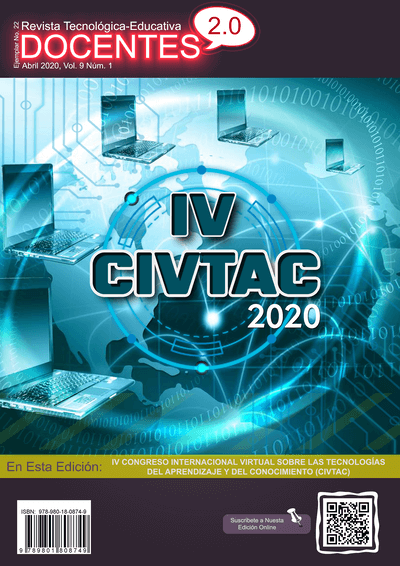Analysis of the application of the cognitive theory of Jerome Bruner as a mechanism to Strengthen Environmental Behavior in Students of the Second Degree of the Institution
 DOI:
https://doi.org/10.37843/rted.v9i1.110
DOI:
https://doi.org/10.37843/rted.v9i1.110
Main Article Content
Abstract
This research aimed to analyze the application of the Cognitive Theory of Jerome Bruner as a mechanism to strengthen environmental behavior in students in the second grade of the Chuniza Educational Institution. For this purpose, a bibliographic review was carried out on the relevant aspects of the theory, as well as the work at international, national and regional levels, which were very useful for methodological design, strategy approach and analysis of the results. The type of research was qualitative with the Research-Action method, which started from a diagnostic stage where it was possible to establish that the students mentioned required strengthening their environmental behavior, since their lack of knowledge of concepts, the impact of man on nature and nature. final disposal of solid waste, among others, became evident. Based on the above, a didactic strategy was designed using playful, musical, theatrical and poetic elements; aspects that ultimately proved very effective, as dynamism was evident in the development of each activity, inferential and critical analysis of each particular environmental situation and deep reflection on the causes and consequences of the current environmental phenomenon, as well as the creation of commitments that in the end, they will serve as an example for the treatment given to such a thematic peak.
Downloads
Metrics
Article Details

This work is licensed under a Creative Commons Attribution-NonCommercial-NoDerivatives 4.0 International License.
Those authors who have publications in our journal accept the following terms:
- When a work is accepted for publication, the author retains rights of reproduction, distribution of his/her article for exploitation in all countries of the world in the format provided by our magazine and any other magnetic medium, optical, and digital.
- Authors will retain their copyright and guarantee the journal the right first to publish their work, which will be simultaneously subject to the Creative Commons Acknowledgment License (Attribution-NonCommercial-NoDerivatives 4.0 International (CC BY-NC-ND 4.0)). That allows third parties to copy and redistribute the material in any medium or format, under the following conditions: Acknowledgment - You must properly acknowledge authorship, provide a link to the license, and indicate if any changes have been made. You may do so in any reasonable way, but not in a way that suggests you have the licensor's endorsement or receive it for your use. NonCommercial - You may not use the material for a commercial purpose. NoDerivatives - If you remix, transform, or build from the material, you cannot broadcast the modified material. There are no additional restrictions - You cannot apply legal terms or technological measures that legally restrict you from doing what the license allows.
- Authors may adopt other non-exclusive license agreements to distribute the published version of the work (e.g., deposit it in an institutional archive or publish it in a monographic volume) provided that the initial publication in this journal is indicated.
- Authors are allowed and recommended to disseminate their work through the Internet (e.g., in institutional telematic archives, repositories, libraries, or their website), producing exciting exchanges and increasing the published work's citations.
- Request of withdrawal an article has to be done in writing by the author to the Editor, becoming effective after a written response from the Editor. For this purpose, the author or authors will send correspondence via e-mail: [email protected].
- The author will not receive financial compensation for the publication of his work.
- All Docentes 2.0 Journal publications are under the Open Journal System (OJS) platform at: https://ojs.docentes20.com/.
References
Axelrod, L. J., & Lehman, D. R. (1993). Respondiendo a la preocupación ambiental: ¿Qué factores guían la acción individual? Revista de psicologia ambiental, 149-159.
Conpes (2014). Sistema General de Participaciones Vigencia. https://colaboracion.dnp.gov.co/CDT/ Conpes/Social/175.pdf
Corraliza, J., Berenguer, J., Moreno, M., & Martin, R. (2009). La investigación de la conciencia ambiental. Un enfoque psicosocial. https://www.juntadeandalucia.es/medioambiente/web/Bloques_Tematicos/Publicaciones_Divulgacion_Y_Noticias/Documentos_Tecnicos/personas_sociedad_y_ma/cap7.pdf
Cuello, A. (Marzo de 2003). Problemas ambientales y educación ambiental en la escuela. http://www.mapama.gob.es/es/ ceneam/ articulos-de-opinion/2003_03cuello_tcm7-53015.pdf
Gomera, A. (2008). La conciencia ambiental como herramienta para la educación ambiental: conclusiones y reflexiones de un estudio en el ámbito universitario. http://www.mapama.gob.es/en/ceneam/articulos-de-opinion/2008_11gomera1_tcm11-141797.pdf
González, A. (2003). Medio ambiente y participación, una perspectiva desde la psicología ambiental y el derecho. En C. San Juan, J. Berenguer, & J. Corraliza, Un modelo psicosocial de preocupación ambiental. Valores y creencias implicados en la conducta ecológica. (págs. 55-64). Bilbao: Servicio editorial de la Universidad del País Vasco.
Guilar, M. (2009). Las ideas de Bruner: De la revolución cognitiva a la revolución cultural”. http://www.scielo.org.ve/scielo.php?pid=S1316-49102009000100028&script=sci_arttext
Hernández, R., Fernández, C., & Baptista, P. (2010). Metodología de la investigación. Mc Graw Hill.
Hernández, R., Fernández, C., & Baptista, P. (2014). Metodología de la Investigación. Mc Graw Hill.
Marín, L. (2012). Problemática Ambiental. http://www.eco-index.org/search/pdfs/194report_2.pdf
Parra, H. (2013). Generando conciencia ambiental en niños y jóvenes de la Institución Educativa la fuente de Tocancipa para rescatar y preservar el ambiente que nos queda. http://bdigital.unal.edu.co/11499/1/01186767.2013.pdf
Pasek, E. (Marzo de 2004). Hacia una conciencia ambiental. https://www.redalyc.org/pdf/356/35602406.pdf
Pozzo, J. (2006). Teorías cognitivas del aprendizaje. Morata.
Puertas, S. (2009). Psicología ambiental. http://www4.ujaen.es/~spuertas/Private/Tema%209.pdf
Rodríguez, E., & Larios, B. (2009). Teorías del Aprendizaje del conductismo radical a la teoría de los campos conceptuales.
Rodríguez, G., Gil, J., & Garcia, E. (1996). Metodología de la investigación cualitativa. Aljibe.
Romero, C. (2005). La categorización un aspecto crucial en la investigación. http://aprendeenlinea.udea.edu.co/lms/moodle/file.php/727/la_ categorizacion_un_aspecto_crucial_en_la_investigacioncualitativa.pdf
Stern, P. (2000). Nuevas teorías ambientales. Hacia una teoría coherente del comportamiento ambientalmente significativo. Revista de asuntos sociales.
Suárez, I. (1 de Abril de 2016). Conducta ambiental responsable en estudiantes de secundaria. http://vinculando.org/ecologia/conducta-ambiental-responsable-estudiantes-secundaria.html






